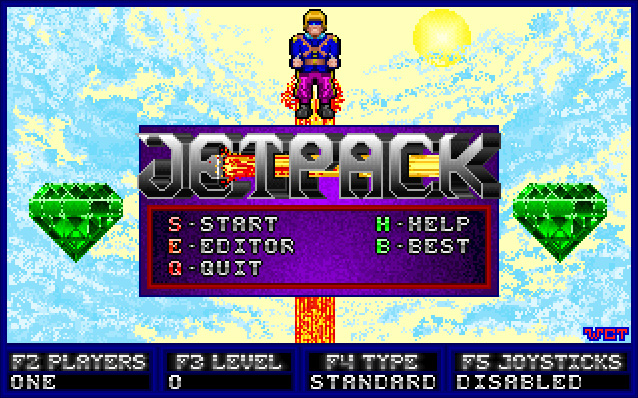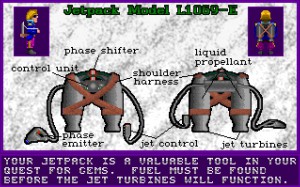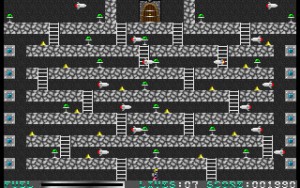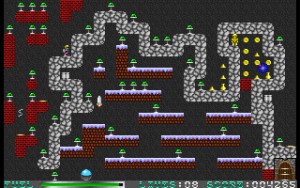I often imagine old shareware authors to be a rare race of mythical beast; some kind of hulking mammoth or fleeting spirit that existed only at some point between 1985 and 1994 and only just long enough to craft a single piece of vibrant CGA wonderland before disappearing forever. As an awkward youth who came to know many of these shareware games through bargain bin CDs sold at WalMart, I saw many of these authors as undiscovered legends. Who were these people? I felt like I was the only person in the world who would ever bother to ask. Somehow these men had created no-budget games out of their basements, and over a decade later and a thousand miles away an eleven year-old boy sat staring at their names on a computer screen. These names really have no more significance than any other name in the phone book, other than that they were in my computer games right after the words “Created by”. It’s like finding a stranger’s really geeky diary and creating some kind of connection with him as you admire his notes and doodles. I wanted those authors to be artists and celebrities that the world could follow, not just mysterious names on an obsolete title screen.
Now, after years have passed and I have discovered the endless tomes of trivia that make up the internet, I find that many of these shareware games were not the unbelievably sparse gems that I had thought. Apparently there were lots of other awkward kids who grew up fondly remembering experiences with the same 500kb masterpieces that I did. The world gets a little bit smaller, and those authors get a chance to become a little less mysterious.
I am inspired to write about Jetpack tonight because it’s creator has taken that chance and has returned to the public eye with plans of a sequel, thus hoisting himself above the oceans of forgotten designers and etching his name among the cult game legends who still brave the Earth today. Adam Pedersen created and published Jetpack in 1993 through the same BBS that introduced many Apogee Software hits to the world. Jetpack was one of the aforementioned shareware games that I spent a pretty good amount of time with, and later I read that it was actually quite popular when it was first released. Well, as popular as these things could get at the time.
The game is very much a take-off on the classic Lode Runner… except with a jetpack. Each level is a single screen made up mostly of platforms and ladders. The object is to collect every green gem in each level and escape out of a large arched doorway. Each level is populated by a battalion of bizarre enemies who will attempt (with varying degrees of effort) to kill you. Apart from running, jumping, and climbing, the player is given two main tools for staying alive. First is the “Phase Shifter.” Similarly to Lode Runner, this tool allows you to temporarily destroy the platforms that make up the level, creating passages for you to pass through or traps for your enemies to fall into. The second is the titular jetpack, which is your only means of free vertical travel. However, flying around on your fancy jetpack requires fuel that you have to find in each level.
Alright, so the basic premise is easy enough to swallow. As you get familiar with the tools at your disposal and the movement patterns of the different classes of enemies, you begin to effectively “phase” pathways for yourself and jet away to where your pursuers cannot follow. But this simple game of keepaway is quickly made into an elaborate puzzle as the game introduces a slew of different platform bricks. Some of these take much longer to phase through or cannot be phased through at all. Some can only be phased through if approached from a specific angle. Other elements, like conveyor belts, escalators, teleporters, icy platforms, areas that drain your fuel and remotely controlled gates, make for dozens of wildly different puzzles. What I’m getting at here is that there is an absurd combination of elements in Jetpack that allows for a wide variety of puzzles.
What Jetpack achieves here is the creation of a system of objects, enemies, items, and tools that is bigger than the game itself. The game really is just a set of levels that utilizes the system. This is further evidenced by the in-game level editor which lets you create your own levels. There are 100 levels in the original Jetpack, and yet because of the sheer amount of different elements in the game you could easily make 100 more without repeating yourself. I think this, more than anything, is why Jetpack is a triumph. Each level is a big puzzle, but the player’s options for interaction are vast. A Rubik’s Cube can only be rotated and a bishop can only move diagonally, but our Jetpack hero moves freely across the puzzle and can alter it’s shape to suit his needs. It’s a great puzzle game BECAUSE it’s a solid action game.
Many action games introduce puzzle elements and fail, resulting in an experience that doesn’t really challenge your problem-solving skills but rather makes you stop the action in order to make you jump through some hoops. Let’s use Doom as an example. Doom’s main challenge for the player is to outwit and out-shoot a slew of monsters in order to reach the end of a level. The presence of these monsters directly affects the objective state of the player (amount of remaining health, ammo etc) as well as how the player will decide to play the level. Let’s introduce one of Doom’s secondary elements to the equation. Many levels have locked doors that the player must find keys for before he can continue. These are Doom’s non-action elements. These are the parts of Doom that are supposed to be a kind of challenge that is different from blasting monsters. These locked doors do not have variable solutions, and so the player will not strategize differently about unlocking said door. All the player can do is find the key, then the corresponding door. The player really isn’t challenged by this, only burdened. It takes no planning or strategy to pick up the key or unlock the door itself, and a locked door or missing key will not kill the player. In fact, the only real hindrance will again be the monsters that may be guarding said keys. Doom is a great action game that injects puzzle elements that are so simple that they serve not as challenges for the player, but simply as road bumps to help draw out the experience and give the player’s adventure more weight. The secondary challenge in this case just plain FEELS secondary. Jetpack doesn’t have this problem. The challenges that a Jetpack player must face were created specifically for the tools that the player was given, and vise versa. Unfortunately for Doom, a blue door that needs a blue key was not specifically designed for a player whose main tools are shotguns and chainsaws.
Mr. Pedersen deserves to continue his game development rockstardom. Jetpack completely nails many core elements of a great puzzle game without making me feel like I’m sitting in front of a stack of Sudoku books wishing I had something better to do. I’m really glad he has decided, after all these years, to work on Jetpack 2. There is a lot of soul captured in these smaller independent productions, and we are fortunate enough to live in times where that soul doesn’t have to die in the bottom of a pile of bargain bin CDs at WalMart. You should check out the ongoing production of Jetpack 2 at http://www.jetpackhq.com/blog/ He’s taking in a lot of feedback from fans about where the game’s going in. Let him know what a good job he’s doing, and that you were a big fan back in ’93.
You can download the original Jetpack as well as many custom levels and themes for free at http://www.adeptsoftware.com/jetpack/





